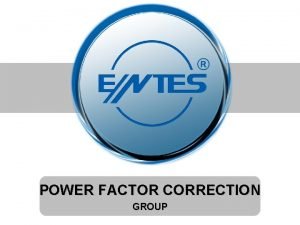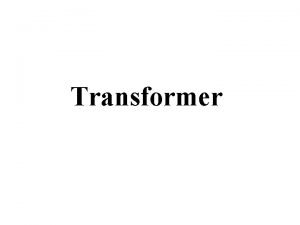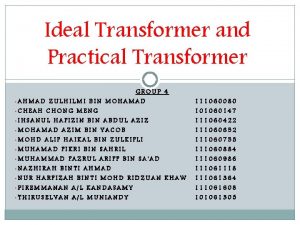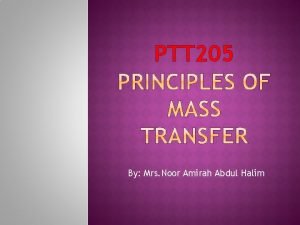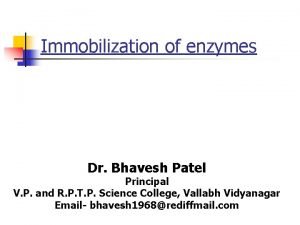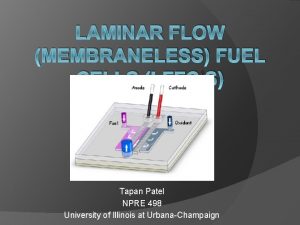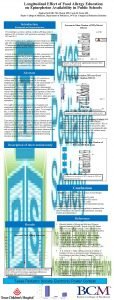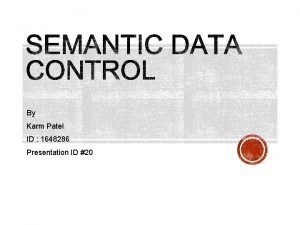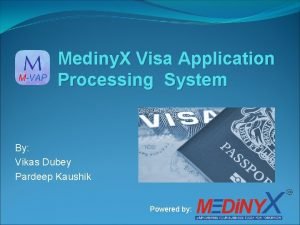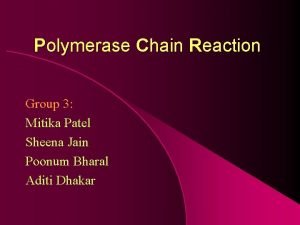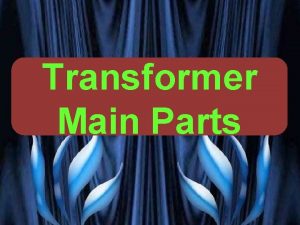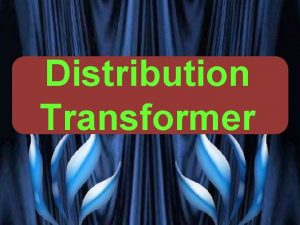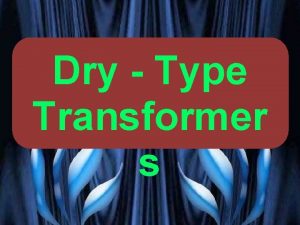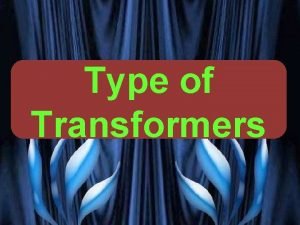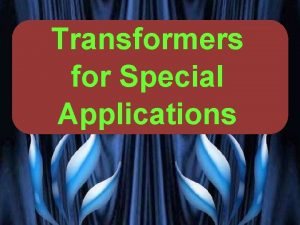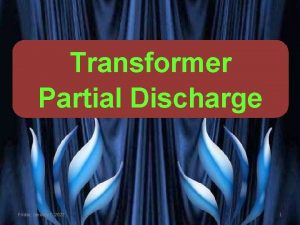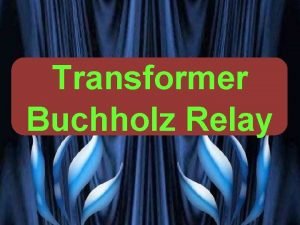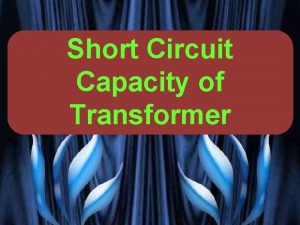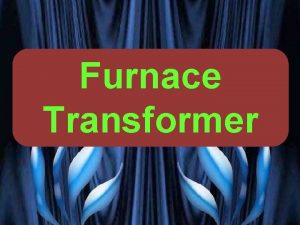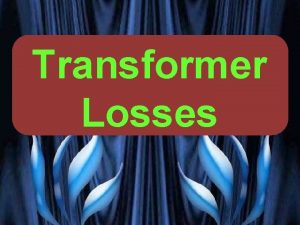TRANSFORMER ENCYCLOPAEDIA Reactors VG PATEL TRANSFORMER ENCYCLOPAEDIA REACTORS





























- Slides: 29

TRANSFORMER ENCYCLOPAEDIA Reactors VG PATEL

TRANSFORMER ENCYCLOPAEDIA REACTORS What is the difference between transformer and reactor? A transformer is composed of two coils and wrapped around a core, while a reactor is made up of one coil of wire. A transformer is used to increase or decrease the voltage, while a reactor is used to isolate circuits from a noisy back ground or to inject lagging KVAR/MVAR in to power system to control the voltage level. In transformer core air-gap increases iron losses whereas in reactor core, deliberately air-gap is introduced. A reactor is an inductor, so has only one winding. A transformer, on the other hand, has two windings: a primary and a secondary. Saturday, February 20, 2021 2

TRANSFORMER ENCYCLOPAEDIA REACTORS Reactors: Reactors are equipment of transformer family. A reactor has a predominantly inductive coil. Reactors are used in the power system network for current limiting and for compensation of reactive power. There are two types of reactors (1) Series reactors, connected in series for current limiting and (2) Shunt reactors, connected in shunt, for compensation of reactive power. Oil insulated Reactors are similar to transformers in external appearance and have some design features similar to those of power transformers. Air-core dry type reactor looks like a large coil. Saturday, February 20, 2021 3

TRANSFORMER ENCYCLOPAEDIA REACTORS Reactors are necessary in following applications: Series Reactors are necessary for limiting short circuit currents, for limiting inrush currents while switching-in, for limiting current surges with fluctuating loads, for smoothing the current waveform, for giving stored energy for satisfactory operation of convertors, neutral grounding reactors, etc. Shunt Reactors are necessary for shunt harmonic filters, and for providing reactive power compensation for long EHV AC lines, i. e. for injecting LAGGING VARS into system for restricting over-voltage. Saturday, February 20, 2021 4

TRANSFORMER ENCYCLOPAEDIA REACTORS LET US DISCUSS FIRST TWO MAIN TYPE OF REACTORS; v. SERIES REACTOR & v. SHUNT REACTOR Saturday, February 20, 2021 5

TRANSFORMER ENCYCLOPAEDIA REACTORS DEFINITION OF A SHUNT REACTOR IEC 289 DEFINES SHUNT REACTORS AS: “REACTORS INTENDED FOR PARALLEL CONNECTION IN A SYSTEM TO COMPENSATE FOR CAPACITIVE CURRENT” Saturday, February 20, 2021 6

TRANSFORMER ENCYCLOPAEDIA REACTORS FUNCTIONS OF A SHUNT REACTOR 1. INJECT REACTIVE POWER TO COMPENSATE LARGE CAPACITIVE CURRENTS THERE BY MAINTAINING GRID VOLTAGES WITHIN LIMITDURING CHARGING AS WELL AS UNDER LIGHTLY LOAD CONDITIONS (FERRANTI EFFECT) 2. LIMIT DYNAMIC OVER-VOLTGES DURING - LOAD REJECTION - SWITCHING IN / SWITCHING OFF - LINE TO GROUND FAULT CONDITIONS Saturday, February 20, 2021 7

TRANSFORMER ENCYCLOPAEDIA REACTORS BASIC DESIGN PHILOSOPHIES OF A SHUNT REACTOR 1. CORELESS WITH MAGNETIC SHIELDED OR SHELL TYPE - V/I CHARACTERISTIC LINEAR UPTO 1. 5 pu CAN BE EASILY ACHIEVED - REACTANCE IN SATURATED REGION IS ABOUT 60 -70% OF REACTANCE IN UNSATURATED REGION. - LOWER FLUX DENSITIES Saturday, February 20, 2021 8

TRANSFORMER ENCYCLOPAEDIA REACTORS BASIC DESIGN PHILOSOPHIES OF A SHUNT REACTOR 2. GAPPED CORE - V/I CHARACTERISTIC LINEAR UPTO 1. 5 pu CAN BE ACHIEVED. - REACTANCE IN SATURATED REGION IS ABOUT 2030% OF REACTANCE IN UNSATURATED REGION. - HIGHER FLUX DENSITIES, COMPACT SIZE. - FIVE LIMBED CONSTRUCTION TO ACHIEVE XO = 0. 9 TO 1. 0 X 1 Saturday, February 20, 2021 9

TRANSFORMER ENCYCLOPAEDIA REACTORS GAPPED CORE SHUNT REACTOR MANUFACTURING PHILOSOPHY MAJOR COMPONENTS OF ACTIVE PART : - CORE PACKETS SLATE SPACERS (GAP) YOKES AND END LIMBS ELECTROSTATIC SHIELD HIGH VOLTAGE WINDING LAMINATED YOKE SHUNT CORE-COIL CLAMPING SYSTEM Saturday, February 20, 2021 10

TRANSFORMER ENCYCLOPAEDIA REACTORS CEA SPECIFICATIONS OF SHUNT REACTORS • • STANDARD RATINGS RATED VOLTAGE LINEARITY BIL, LINE, LI/SI BIL, NEUTRAL, AC/LI PD AT 364 k. V XO X 1 • VIBRATION LEVEL • NOISE LEVEL Saturday, February 20, 2021 50, 63, 80 MVAr 420 k. V STRAIGHT UPTO 1. 5 PU 1300/1050 k. Vp 230 k. V RMS/550 k. Vp LESS THAN 500 p. C 0. 9 TO 1. 0 200 max. P-P 81 d. BA FOR 50, 63 MVAr 83 d. BA FOR 80 MVAr 11

TRANSFORMER ENCYCLOPAEDIA REACTORS Shunt Reactor and Transformer both appear similar in construction. Reactors are also often equipped with Fans for cooling similar to Power Transformers. However, there are major differences between the two. While a Power Transformer is designed for efficient power transfer from one voltage system to another, a shunt reactor is intended only to consume reactive VArs (or in other words it can be stated as to produce lagging VArs). Saturday, February 20, 2021 12

TRANSFORMER ENCYCLOPAEDIA REACTORS Thus, there are more than one winding on a Power Transformer with magnetic core which carry the mutual flux between the two. In reactor there is just one winding. The core is not therefore meant only to provide a low reluctance path for flux of that winding to increase the Inductance. In case of a Power Transformer, primary Ampere. Turns (AT) is sum of exciting AT and secondary AT. AT loss (in winding resistance, eddy loss and hysteric loss) is kept to as minimum as possible. Exciting AT is small compared with the secondary AT. Rated current is based on the load transfer requirement. Saturday, February 20, 2021 13

TRANSFORMER ENCYCLOPAEDIA REACTORS Magnetizing current is small and is negligible value when compared with the secondary rated current. Further, since mutual flux is main flux which results in transformation, leakage flux is kept small and will be based on fault current limitation. In case of a Shunt Reactor due to absence of other windings, all primary AT is equal to the exciting AT. Similar to a Power Transformer, loss in AT (in winding resistance, eddy current and hysteresis) are also kept to minimum by design. Magnetizing AT is major component of a Shunt Reactor magnetizing current is its rated current. Saturday, February 20, 2021 14

TRANSFORMER ENCYCLOPAEDIA REACTORS Since a Shunt Reactor magnetizing current is large, if it is designed with Iron alone as a Power Transformer, there will be large hysteresis loss. Air gaps in Iron core are provided in a Shunt Reactor to reduce this loss and to minimize the remanent flux in the core. Thus a Shunt Reactor may also be constructed without iron (air-core). Saturday, February 20, 2021 15

TRANSFORMER ENCYCLOPAEDIA REACTORS Dry type Reactors are constructed as single phase units and are thus arranged in a fashion to minimize stray magnetic field on surrounding (in the absence of metallic shielding). When such an arrangement is difficult, some form of magnetic shielding is required and designed with care to minimize eddy current loss and arcing at any joints within the metallic loops. One of the advantages of dry type reactor is absence of inrush current. Oil immersed reactors can be core-less or with gapped iron core. These are either single phase or three phase design with or without fan cooling. These are installed within tanks which hold oil & act as metallic magnetic shields. Saturday, February 20, 2021 16

TRANSFORMER ENCYCLOPAEDIA REACTORS By construction, a Shunt Reactor can be oil immersed or dry type for both with and without iron core. In some cases, a Shunt Reactor may have additional small capacity winding which can provide power for small station power loads. Since Shunt Reactor rating is normally based on MVAr rating, this added station load VA shall be accounted for in designing the Reactor for such applications. Saturday, February 20, 2021 17

TRANSFORMER ENCYCLOPAEDIA REACTORS TYPES OF SHUNT REACTORS Shunt reactors are used in high voltage systems to compensate for the capacitive generation of long overhead lines or extended cable networks. The reasons for using shunt reactors are mainly two; The first reason is to limit the over voltages (mainly due to Ferranti effect for lightly loaded line OR simply charged line receiving end breaker is off) and the second reason is to limit the transfer of reactive power in the network. If the reactive power transfer is minimized i. e. the reactive power is balanced in the different part of the networks, a higher level of active power can be transferred in the network. Reactors to limit over voltages are most needed in weak power systems, i. e. when network short-circuit power is relatively low. Saturday, February 20, 2021 18

TRANSFORMER ENCYCLOPAEDIA REACTORS Reactors to achieve reactive power balance in the different part of the network are most needed in heavy loaded networks where new lines cannot be built because of environmental reasons. Reactors for this purpose mostly are thyristor controlled in order to adapt fast to the reactive power required. Especially in industrial areas with arc furnaces the reactive power demand is fluctuating between each half cycle. In such applications there are usually combinations of: Thyristor controlled reactors (TCR) and Thyristor switched capacitor banks (TSC). Saturday, February 20, 2021 19

TRANSFORMER ENCYCLOPAEDIA REACTORS These together makes it possible to both absorb, and generate reactive power according to the momentary demand. Four leg reactors also can be used for extinction of the secondary are at single-phase reclosing in long transmission lines. Since there always is a capacitive coupling between phases, this capacitance will give a current keeping the arc burning, a secondary arc. By adding one single-phase reactor in the neutral the secondary arc can be extinguished and the singlephase auto-reclosing successful. Saturday, February 20, 2021 20

TRANSFORMER ENCYCLOPAEDIA REACTORS Typically shunt reactors are wye connected to earth. Some engineers when specify reactors ask for the zero sequence impedance from the manufacturer. However no secondary windings are present on reactors so zero sequence currents cannot be exist because they are not compensated (standard delta- wye or wye- wye transformers allow to flow zero sequence currents when stars are earthed). Saturday, February 20, 2021 21

TRANSFORMER ENCYCLOPAEDIA REACTORS SERIES REACTORS (1)FOR AC ARC FURNACES (2)FOR MINIMIZING FLUCTUATIONS (3)FOR LIMITING S. C. / FAULT CURRENT Using its consolidated technology and the experience it has accumulated in the construction of oil-filled series reactors for AC arc furnaces, TES designs, builds, tests, commissions and maintains oil-phase reactors with power ratings of up to 60 Mvar and voltages of up to 132 k. V. Saturday, February 20, 2021 22

TRANSFORMER ENCYCLOPAEDIA REACTORS In arc furnaces, which use long arcs and high levels of secondary voltage, it is normally essential to introduce an additional reactor, which serves to stabilize the arc during fusion and to optimize the functionality of the furnace. The furnace transformers are often used in series with reactors which have some regulation taps operated with either an on-load tap changer (OLTC), for maximum flexibility, or with a no-load tap changer (NLTC). The reactor can be built inside the main transformer cabinet, or alternatively, it can be entirely separate from it or located next to it. Saturday, February 20, 2021 23

TRANSFORMER ENCYCLOPAEDIA REACTORS This solution makes it possible to eliminate the costs of cabling the MV connections between the transfor-mer and the reactor, thus making it possible to carry out maintenance work on the reactor without having to shut off the transformer. In this way, the overall reliability of the system can be enhanced. The experience that TES has built up has allowed to company to become a leading brand both nationally and internationally for in series reactors for arc furnaces. The company’s products are used across a wide spectrum of applications by a plethora of major clients. Saturday, February 20, 2021 24

TRANSFORMER ENCYCLOPAEDIA REACTORS Here, it describes reactors for number of different applications. Supplementary information can be found in IEC 60076 -6 Part 6: Reactors. Over and above Shunt reactors and Series reactors (Current limiting reactors), following few are for different applications; Saturday, February 20, 2021 25

TRANSFORMER ENCYCLOPAEDIA REACTORS Neutral earthing reactors: Capacitor damping reactors are used for limiting the inrush currents occurring during the switching of capacitor batteries to A. C. networks. They are connected in series with the capacitors. Tuning (Filter) reactors: Tuning reactors are connected with capacitors to tuned filter circuits with resonance in the audio frequency range for reducing, blocking or filtering harmonics or communication frequencies. Saturday, February 20, 2021 26

TRANSFORMER ENCYCLOPAEDIA REACTORS Earthing transformers (Neutral couplers): Earthing transformers are used to create a neutral point in a threephase system, which provides possibility for neutral earthing. Arc suppression reactors: Arc-suppression reactors are also named earth fault neutralizers or Petersen-coils after W. Petersen who launched the idea of this particular reactor application early in the previous century. Smoothing reactors: The direct current that is coming from the rectifier in d. c. systems has superimposed harmonic components, also called ripple. The smoothing reactor is connected in series with the rectifier (convertor) and the whole load current, including the D. C. current and small A. C. harmonic currents, flows through it. Saturday, February 20, 2021 27

TRANSFORMER ENCYCLOPAEDIA OPEN FORUM Saturday, February 20, 2021 28

TRANSFORMER ENCYCLOPAEDIA THANQ Saturday, February 20, 2021 29
 Low voltage three phase choke coil filter reactor in pfc
Low voltage three phase choke coil filter reactor in pfc Why transformer is a static device
Why transformer is a static device Ideal vs practical transformer
Ideal vs practical transformer Dr toral patel
Dr toral patel Sheena patel md
Sheena patel md Pantun berkait
Pantun berkait Rs patel and co
Rs patel and co Dr nisha patel
Dr nisha patel Dr amrita patel
Dr amrita patel Bhavesh patel md
Bhavesh patel md A. d. patel
A. d. patel Patent valuation methodology
Patent valuation methodology Is it really
Is it really Anisha patel md
Anisha patel md Gamesense.isis
Gamesense.isis Dr tapan patel wikipedia
Dr tapan patel wikipedia Manali patel md
Manali patel md Blake patel only connect
Blake patel only connect Trisha patel orlando
Trisha patel orlando F
F Dr nidhi patel
Dr nidhi patel Uci websoc
Uci websoc Dipika patel md
Dipika patel md Karm patel
Karm patel Dr vikas patel
Dr vikas patel Fay patel
Fay patel Dr ebrahim patel
Dr ebrahim patel Sunsamrt
Sunsamrt Mobile virtual reality service
Mobile virtual reality service Purpose of pcr
Purpose of pcr
